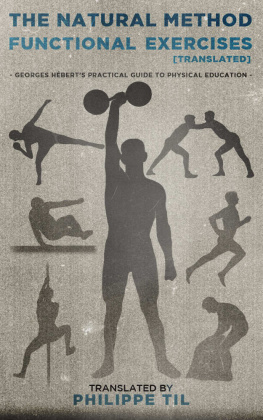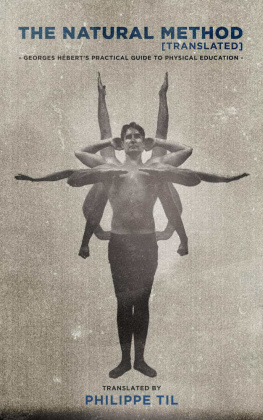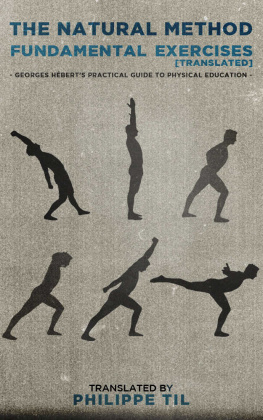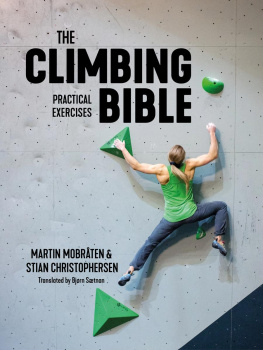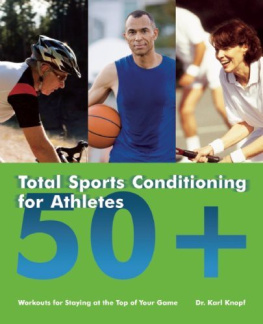Natural Method
Functional Exercises
Table of Contents
INTRODUCTION
While the entire method consists of four main parts (the expos of the method, the fundamental exercises, a.k.a basic educational exercises, the indispensable utilitarian exercises, a.k.a functional exercises and the final part being games, sports and manual labor), I chose to break down the method, in my translation work, into three separate books not only from a logistical standpoint, but also from an assimilation standpoint.
Indeed, much like in our own evolutionary process (inside of our individual lifetime), the clich goes crawl before you walk before you run.
The first book allows us to understand what constitutes the method, tells us the what and the why. The second and third books are about the how. They respectively correspond to the primer, or prerequisite for good movement before being able to graduate to development of skills through functional exercises.
Like any good trilogy, you need a solid ending, an apogee, which is why I chose to include Hberts fourth part, where the application of everything that makes up the method is applied to show its efficaciousness. It is something oft discussed and not applied enough in our fitness culture. Aside from the pro athletes whose end goal is made better by their strength and conditioning programs on top of the practice of their given sport/game (the latter being the end goal), or the recreational athletes enjoying playing basketball, martial arts, surfing or whatever is of interest to them, we rarely see people go beyond the gym and the visual aesthetic, or training for enjoyment beyond health benefits.
I have to admit to a certain point of contradiction in my process; I have made a point to retain Georges Hberts writing style, which involves a lot of repetition. Through rote, it is found we learn best: we practice a punch, tennis serve, a golf swing etc. over and over again. I am aware of only one other work of translation of Hberts method, but it was abridged on purpose and in my opinion losing the essence and style intrinsic to the method, like a two-hour film adaptation of long saga of books, with necessary edits and character omissions. And of this I am guilty to an extent, as I intentionally decided to only tease the translation of two chapters (swimming and self-defense/combative techniques). While this may constitute an affront to Hberts purists, the decision to do so was made for two reasons:
Logistical : providing the readers enough time to assimilate the method between books, yet balancing my schedule so that not too much time would span between releases to maintain interest (something that may not apply once all the books are out).
Realistic : because the population in majority has a low % of swimmers, coverage of the swimming and water rescue techniques seemed less relevant, subjectively and objectively (the latter from a wider audience interest standpoint). Alternatively, the omission of the chapter on self-defense/martial arts training may have a vast audience and is popular with the advent of mixed martial arts events, and keeping that in mind, individual preferences and efficaciousness of techniques becomes less relevant. Indeed, readers interested in the subject for the sake of actual training and practice may decide that they like Krav Maga, Brazilian Ju-Jitsu, Muay Thai or other martial art better. The choice simply was to not be a voice lost in the crowd.
The purpose of the books is to expose readers to the quality of fitness throughout the ages, with a system established over a century ago, itself stemming from centuries of application prior to that. With the hopes that said exposition would yield to going out in the field and implementing the method into ones personal fitness program, I chose the minimum effective dose that would reach the widest audience for this book release.
To the readers interested in the historical aspect of fitness and the entire presentation of Georges Hberts work, I do make the promise of translating the shortened chapters, with some additional archived content, in a compendium of all three of the translated books, at a later date. I also promise the release of companion books to the method, as well as training programs and video content.
INDISPENABLE UTILITARIAN EXERCISES
(aka FUNCTIONAL)
CHAPTER 1- MARCHING/WALKING
General considerations. Principal benefits on the body. Progression mechanisms. Beneficial or economical cadence. Foot hygiene. Resistance or distance walks/marches. Speed walks.
Translators note: the terms march(ing) and walk(ing) will be used intermittently and alternatively, as the French language uses the same term for both, even if the term marching has a more military consonance.
1. GENERAL CONSIDERATIONS
Walking is the most natural means of locomotion. It is both the simplest and most economical way to move using the legs.
It is useless to specifically stress the importance of this normal pace whose applications are constant throughout life.

DISTANCE OR RESISTANCE WALK
General stance of the body during the double push from the feet: the forward leg is slightly bent and the foot touches the ground almost flatly, heel first.
The back leg is extended as much as possible. The bodys weight rests both on the ball of foot of the back leg and the heel of the front leg.
Walkings main benefit: to activate respiration and circulation; to develop the lower limbs; and finally, to increase sustained strength. Its action on the respiratory and circulatory functions is always moderate; it is an excellent hygienic form of exercising for all ages. (Translators note: the clarification of the term hygienic is described in the first book of the trilogy)
During marching, the bodys progression is related to the motion of one leg brought alternatively in front of the other. The impulse is produced both by the push from the foot against the ground and the extension of the lower limb. The impulse is generated alternatively by each leg: as soon as one leg ends its impulse, it is immediately relayed by the other.
During marching, there is always one foot, and at times both feet, in contact with the ground or with ground support. The constant support of the body on the ground is a characteristic element of marching.
The moment of double support, when both feet are on the ground, immediately precedes the relaying of one leg to the other. At that moment, the body is supported both on the ball of foot of the back leg ad the heel of the front leg.
Walking is a succession of steps.
A step is the period between the landing of one foot on the ground and the immediate consecutive landing of the other foot.
The stride is the distance separating two consecutive landings.
This distance is measured from heel to heel or toe to toe.
The cadence is the amount of steps performed in a minute.
The pace or speed of walking (or distance covered in a minute) is equal to the product of the stride with its cadence.
There is a relation between the stride and the pace.
If, while walking at a relatively slow speed, one were to increase their cadence, meaning the amount of steps per minute, the stride increases naturally. But this increase has its limits. If the cadence continues to increase, the stride can no longer increase and goes through a maximum before diminishing.
After experimenting with this, the pace where the stride reaches its maximum corresponds to a cadence of roughly 140 steps per minute with an adult of average height. Beyond that, the speed of walking if of course greater, but it isnt achieved with long, but rather short steps.
Next page
